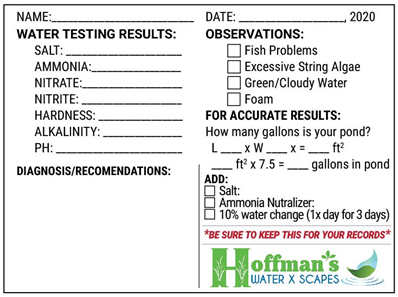Pond Water Treatments
So many products, but what do they do? Do I need to use them all? Let this guide help “clear it up for you.”
Beneficial Bacteria colonizes within your biological pond filter, breaks down ammonia from fish waste and decomposing debris and turns it into Nitrates - nutrients for your pond plants.
- Beneficial bacteria should be added on a regular basis from the time water temperature comes up to 50°F in the spring, until when the water temperature drops to 50°F in the fall.
- Excess string algae in your koi pond, longer than an inch on the stone, may be an indication that beneficial bacteria is not present or is not working.
- High pH (9+) will dramatically reduce the effectiveness of beneficial bacteria.
Water Conditioner makes tap water safe for fish and pond plants by releasing chlorine, detoxifying ammonia and heavy metals and protecting the slime coat on pond fish.
- Water conditioner should be added any time new water is added to the pond from the faucet.
- Only the amount of water being added needs to be treated.
- For example, if 100 gallons of new water is being added, only add treatment for 100 gallons of water.
Sludge & Muck Remover is used to enhance the good pond bacteria, and stimulate the enzyme activity in reducing sludge and muck in the bottom of the pond.
- Sludge & Muck Remover is recommended to be used in conjunction with beneficial bacteria treatments.
- The digestion of sludge and muck increases the consumption of dissolved oxygen from the water. Have good aeration and remember the warmer the water temperature the less dissolved oxygen it holds. Do not overdose with Sludge & Muck Remover at any time, but be particularly careful when water temperatures are closer to 80 degrees F.
- We recommend the use of a pond aerator when using a sludge and muck remover to help protect fish.
Nitrifying Bacteria is used to stimulate the growth of certain varieties of bacteria that break down Ammonia (from fish waste, uneaten fish food, plant waste, etc.) into Nitrites and then breaks down Nitrites into Nitrates. Each step renders these forms of nitrogen into less harmful elements to the fish in your pond.
- It takes up to 8 weeks for this cycle to complete.
Algaecides are chemical treatments designed to oxidize and kill algae growth in pond water.
- For best results, remove as much algae from the pond as possible, by hand, before using pond algae treatments. This will help reduce the amount of nutrients released from dead plant life which will feed more algae.
- Use algaecides only when necessary and be careful not to overdose.
- A well-balanced ecosystem should require limited use of algaecides, if at all.
Flocculants will bind and clump suspended particles that cloud the pond water, creating a clearer appearance.
- Follow dosage directions closely. Using too much of a flocculant will make the water cloudier.
Pond Salt is used as a preventative measure to reduce fish stress. It may also be used in higher concentrations to treat several, but not all, fungal and parasitic problems. *Beware; too much pond salt can kill aquatic plants and snails and be dangerous to fish.
- Salt used in ponds should be pure and non-iodized, with no anti-caking agents.
- We recommend using one (1) cup of granulated pond salt per 100 gallons of pond water. This will set the salinity at approximately 0.08 to 0.1% ppm. This will balance the salt and water pressure inside and outside the body of your pond fish.
Crushed Oyster Shells is a natural pond water treatment used to replace calcium carbonate in the water which aids in “buffering” and reduces pH swings.
When in doubt, test your pond water so you know where your levels are at and keep a record of your results to track progress. Get your 5-in-1 Pond Water Test Strips Online.
*Print the water test sheet (below) to keep record of your pond’s water quality. If a problem arises, bring this information in to the garden center for recommendations.

